Ground robots. From drop systems to unmanned convoys (Part of 1)
Among the three elements represented by sea, sky and land, land is, of course, the most difficult for an unmanned vehicle. While unmanned aerial vehicles (UAVs) and surface or underwater uninhabited systems for the most part operate in a homogeneous space, terrestrial Robots must overcome all types of obstacles which are myriad. They not only complicate the movement of robots, but also limit the range of their communication channels.
In the kingdom of the UAV, the rule is that the smaller the UAV, the greater the influence of wind gusts on it. Ground robots suffer from this size syndrome when physical dimensions affect mobility, at least when it comes to the most classic solutions, namely wheels and tracks, since walking and crawling mechanisms are still far from practical implementation.
Terrestrial mini-robots suffer the most. Their limited mass also affects the range of communication channels and the duration of their work, since they usually operate on batteries.
It is always difficult to divide systems into categories. However, the first category can be safely attributed to systems weighing up to five kilograms, the so-called terrestrial mini-robots (let's set aside the micro category for the future, if it ever appears). The first category has subcategories, namely, abandoned robots up to three kilograms, since heavier robots are more likely to be thrown than to be thrown by devices.
The next range is the middle category, really another world, where the payload is measured in kilograms rather than grams, and where much more functional flexibility is provided. Here the robots themselves weigh from 5 to 30 kg.
For practical reasons, this article discusses only robots that can be used by soldiers on the battlefield from a tactical point of view. For example, robots for the neutralization of explosive objects are considered specialized systems designed to perform a special range of tasks. The purpose of the article is to analyze what is available to the ordinary soldier to increase his security and fighting qualities of flexibility in a real situation.
Another form of “collaboration” between ground-based robots and UAVs is represented here by the HDT Global Protector tracked vehicle, deploying a tethered UAV to provide early warning of transport convoys
It is obvious that many multitasking ground robots can be equipped with a robotic arm-manipulator, grabs, water cannon, etc., which actually turns them into mobile bombs, although this will be just one of many of their roles.
Heavy robots weighing more than 100 kg can be useful on the battlefield in such tasks as reconnaissance, replenishment of supplies, evacuation of victims, etc. For example, as one of the many possible applications, the situation with the Supacat cars, which are used in the British army to bring ammunition to the front line, can be brought. The drivers of these cars are at very high risk, so they can rightly be replaced by robotic systems.
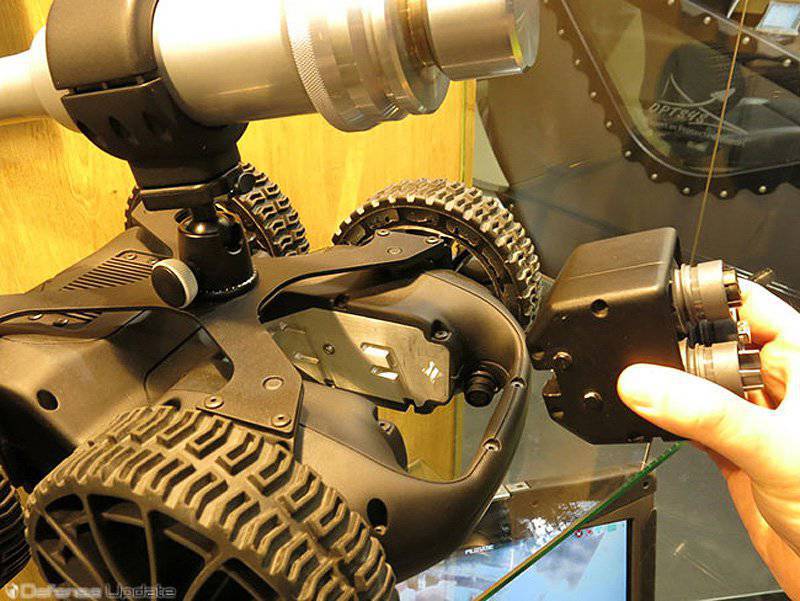
Demonstration of the modular design of Nexter's Nerva robots, which can accept chemical sensors, infrared cameras, tear gas grenades, an audio system, a device for the destruction of explosive objects, as well as a module for installing other devices
Ground-based mini-robots, such as iRobot FirstLook (above), will mostly remain remotely controlled, since increasing their autonomy may be too expensive, at least at this stage. One of the directions, however, could be the improvement of the human-machine interface, which will allow operators to maintain their tactical position when controlling ground robots, as can be clearly seen from the example of the Nexter Nerva robot controller (below)
Fatigue and loss of concentration were identified by the American army as the main causes of accidents in transport supply columns, plus directional land mines contribute to this sad statistic. As a result, a number of companies in the USA and Europe are developing systems that allow transforming a traditional vehicle into an unmanned vehicle. A similar approach can also be applied to the equipment of engineers, that is, the scraper, for example, can be turned into a robotic demining tool.
The great advantage of these systems is that they can be purchased in relatively small quantities and installed on standard trucks or cars on site and then transferred to other machines, either for other tasks or in case of a malfunction of the machine in which they were installed. .
Compared to UAVs, ground-based robots, of course, are less mature from a technological point of view. In a few of them, a developed form of autonomy is integrated, which could significantly reduce the workload on operators and at the same time increase the advantage of their use and make them a real factor in increasing combat readiness. Many arguments are brought against their weapons (this also applies to UAVs), since their reliability is considered to be insufficient (how reliable a person can also be questioned, especially in light of the incidents between his forces in some combat areas). Legal advisers will receive good dividends on the rapid deployment of such armed ground-based robots. However, it is clear that the era of ground-based robots has begun and they will play an increasingly important role on future battlefields.
But now, however, another factor has a disastrous effect on the development of ground-based robots - the financial crisis. In many countries led by America, many programs have been reduced, affecting the development and procurement of some of the systems mentioned in this article. This, along with other events, gave rise to negative processes in the community of ground robots. Several well-known companies are currently struggling with financial problems due to cancellation of orders.
Three programs seem to be alive in the United States today: Advanced Advanced Explosive Ordnance Disposal Robotic System, a common robotic branch of the Common Light Autonomous Robotic Kit, which serves as a means of transporting reconnaissance sensors, and an engineering department robot. Engineer Squad Robot. Another program for the Squad Multi-Purpose Equipment Transport department equipment multipurpose transporter is likely to survive cuts and sequestering of the defense budget.
All robotized systems (air, sea, and land), if they want to attract at least some attention of the US Department of Defense, must comply with the common architecture for unmanned systems Joint Architecture for Unmanned Systems (JAUS) and the Interoperability Profile (IOP) interoperability profile. Head-mounted control systems, reduced workload, semi-autonomous control, the ability to operate several devices simultaneously, appear to be the main development trends in the field of robotic systems.
What does the future look like for ground robots? How many of them will appear on the battlefield in 2020? Hard to say. It is only obvious that this technological development, coupled with the absolute need to reduce losses in the contingents of Western countries deployed in hot spots, will inevitably cause the need to advance deserted systems in all branches of the military operating on land. Very few at the beginning of the century were convinced of the usefulness of UAVs, and now they appear every day in the newsand many are currently being marketed for commercial use. Will this also happen with ground robots? The answer is probably yes, considering that according to the Office for the Development of Robotic Systems, ground robots have saved the lives of more than 800 soldiers while performing combat missions in Iraq and Afghanistan.
French army looks at ground robots
The French Secretary of Defense in June 2014 confirmed the Scorpion Stage 1 Stage and the French Army now intends to launch the 2 Stage, for which robotic systems are an integral part. Robots in operational-tactical forces will have to be used in a dismounted battle, and ground microrobots (and their flying colleagues) must become advanced eyes of a soldier. Other robots of similar sizes could contribute, exerting not only a force on the ground forces of the enemy, but also improving the quality of communication for operational groups, for example, by deploying radio-relay systems.
More advanced microrobots could perform reconnaissance tasks for the higher echelons, taking part in the battles of mechanized forces. Tactical universal robots could conduct contact reconnaissance, replenish supplies and serve as executive elements, while heavier robots could be mainly used for demining and engineering tasks. You can not discount the use of systems that can transform standard vehicles into robots.
Mini Category: New Infantry Tools
In anticipation of the emergence of ground-based nanorobots, the tasks of reconnaissance of observation and collection of information at close range are mainly performed by light ground-based robots capable of moving in restricted areas and having data transmission channels of a limited range. Many of them belong to the category that we can call the category of “abandoned robots”, since they can be abandoned by the operator for a certain distance and height, for example, inside the building, which eliminates the need to move there on their own.
Often considered to be disposable (consumable), they can fit in a pocket or handbag and have small and light control devices, and some are now even controlled by smartphones. Along with light throw robots, there are several heavier robots that are easily dropped from the vehicle (when not equipped with additional sensors), but they can hardly be launched through the first floor window. They remain the preferred systems for the main infantry units, since they do not greatly increase the burden of the soldier and compensate for this by providing him with new, easy-to-use capabilities.
The youngest member of the iRobot family in front of an improvised explosive device. The two trapezoidal levers on the sides in the foreground are called flippers.
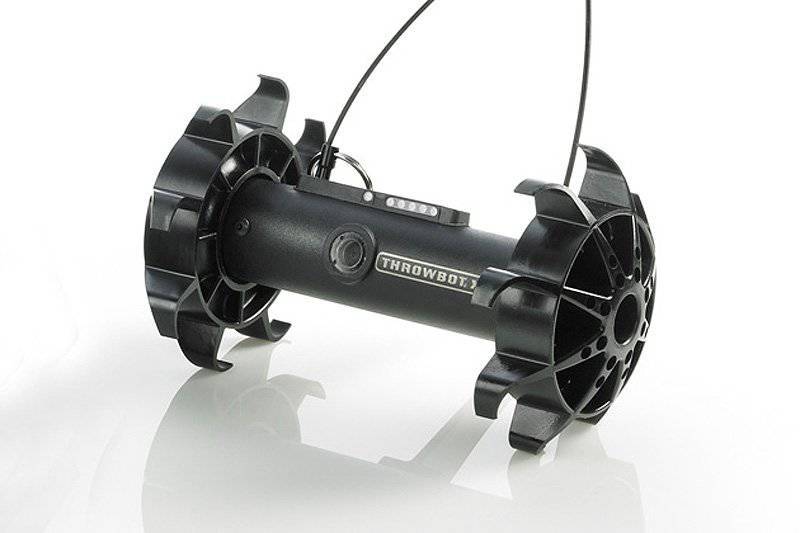
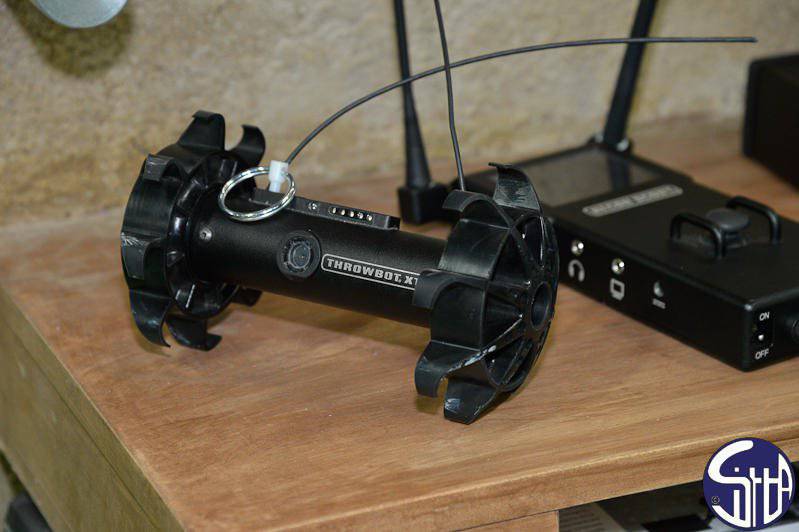
Throwbot XT is one of two best-selling ReconRobotics; second and larger model - Reconscout XL
Thrown
ReconRobotics: ReconRobotics, based in Minnesota, was created in 2006 year, it is one of the fastest growing companies in the field of ground-based robotic systems. 4000 production systems of this company work in the world, equally divided between the military and law enforcement spheres. The US defense budget cuts hit the company hard in the 2014 year after the US Army decided not to buy more than a thousand robots in the 2013 year. This led to a suspension of production at the beginning of 2014, although the company recently reported that a strong international market and law enforcement market would help offset the loss of orders from the US military. Currently, 90% of the company's sales are based on two models: Throwbot XT and Reconscout XL.
The lighter Throwbot XT system from the ReconRobotics family of robots weighs just 540 grams (the average hand grenade weighs from 400 to 500 grams), its production began in the middle of 2012. The comparison with the grenade is further enhanced, because in order to activate and activate the robot, the operator must remove the check from it. The light, tubular design allows you to comfortably grip it and throw it to a distance, as they say in the company, up to 36 meters. The good shock-resistant characteristics of the robot allow you to throw it from a height of 9 meters without any consequences. Inside the tube are two brushless electric motors that rotate the wheels at the ends of the tube, while the rear tail provides balance and orientation. Each wheel with an outer diameter of 114 mm has eight curved blades that maximize the permeability of the obstacles. In addition to the sensors, the tubular case also houses a battery that ensures a one-hour operation time on a flat surface.
The main sensor is a black and white camera for low light with optics, providing 60 ° field of view, and a frame rate of 30 frames per minute; when the light falls below a certain level, the source of infrared illumination is automatically activated, ensuring visibility of more than 7,5 meters. A highly sensitive omnidirectional microphone allows the operator to hear noises or conversations. The acoustic signature of the Throwbot XT robot is very low, in ReconRobotics they declare 22 dB noise at a distance of six meters, which corresponds to a person's breathing at a distance of 20 centimeters. For silent deployment of the robot, there is a small hook at the end of the tail for securing the cord, while ReconRobotics developed SearchStick to deliver it to a height. This is a telescopic aluminum rod with a length of 1,83 meter with an activated latch button (in the folded position, the length of the rod of the entire 0,52 meter); it also serves to return the robot at the end of work or use as a camera extension. The data channel of the Throwbot XT can be tuned to three different frequencies, so one operator can control three robots. The speed of the device is limited to 1,6 km / h, which is quite enough for a system designed mainly for work in buildings or in urban areas. In urban environments, the range is 30 meters, which triples in open areas.
A vivid example of what an abandoned robot can be used for: throwing into the next room and see what happens there.
ReconScout IR is a direct development of the previous robot. It is equipped with a black and white infrared CCD camera with a 60 ° field of view and an infrared illumination that is effective at a distance of more than seven meters.
ReconScout XL develops speeds up to 2,16 km / h, which is higher than that of Throwbot, but its impact strength is lower, as it can withstand a fall from the height of the entire 4,6 meter and a throw to the 9,1 meter. Its wheels with a diameter of 140 mm have six spikes; This robot is somewhat noisier than the previous one, creating an 32 dB noise at work at a distance of six meters. Sensors and communication channel are left unchanged.
ReconRobotic systems are controlled by the Operator Control Unit II (OCUII) control unit, which allows you to see images captured by the camera of the robot on an 3,5 inch display, while all the surrounding sounds are fed into the headphones. OCU II weighs 730 grams, it has a thumb joystick installed, which makes it easy to control the movement of the robot. Two antennas must be extended before the operation of the OCU II, six frequencies are available, the height of the device with the antennas extended is 510 mm.
Historically, the main market for ReconRobotics was the United States with thousands of systems sold, however, its robots were also sold to several more countries. In Europe, its abandoned systems operate in Denmark, France, Italy, Norway, Switzerland and the UK, in addition, the company's robots are operated in Australia, as well as in Egypt and Jordan. In 2013, the ReconRobotics robots were taken by the PEO Soldier Soldiers' Equipment Department into the Soldier Enhancement Program as part of the separation level sensory sets. The evaluation process should be completed by 2015 year. ReconRobotics is currently working on the technical development of a digital version of the Throwbot XT; This will add the ability to reconfigure the radio channel, which becomes an indispensable condition in the international market.
Nexter: In 2012, the French company Nexter revealed its interest in ground-based mini-robots, launching a prototype of an abandoned Nerva 4x4 robot weighing 4 kg. After further development and implementation of the production process, the original Nerva robot received the designation Nerva LG, the first of the family of light robots, the development of which was started by the newly formed Nexter Robotics division. If the equipment is not installed on top of the robot, the Nerva LG is completely reversible, in other words, it is ready to work right after the throwing. The rear mounted handle makes it easy to carry and throw. It can be dropped from a height of three meters and thrown to the side for seven meters. Nerva LG has two speed ranges: from zero to 4 km / h and the second from 0 to 15 km / h. The first mode is standard, it allows to perform precise control and orientation, and when high speed is needed, the operator presses a button on the end of the joystick, switching the device to speed mode. Standard wheels have a diameter of 150 mm, although special wheels for sand with wider treads and transverse grippers can be installed, a set of tracks is also available in difficult times. For special forces there is a set for swimming with floats elements and paddle wheels.
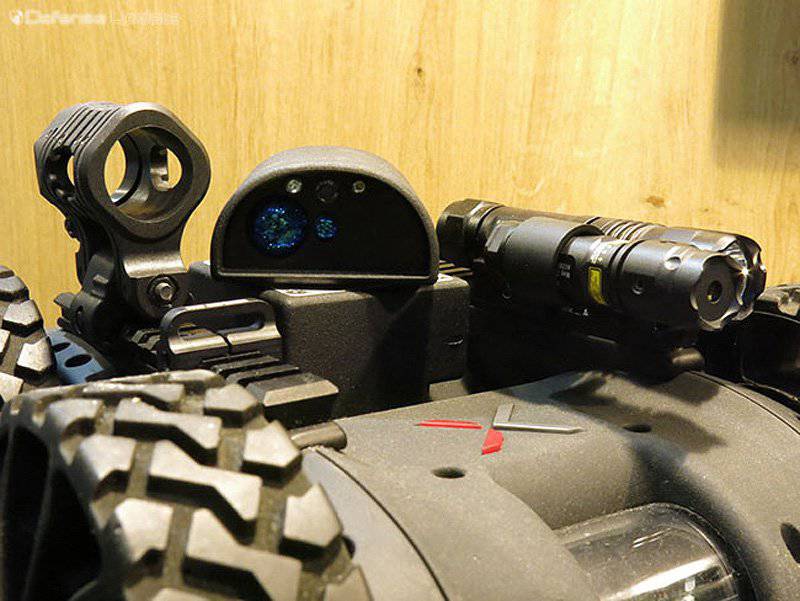
For their Nerva robots, Nexter has created quick-change modules that allow you to set a new task for the system without delay.
Fully modular robot based on the concept of "one click", which allows you to quickly replace the wheels and battery. Nerva LG is equipped with standard sensors, which at the expense of four cameras provide a circular view (front camera with high resolution has a backlight system), the operator hears all sounds thanks to an omnidirectional microphone. Picatinny rails or configurable straps provide a mechanical interface with devices. The battery in the system supplies a voltage of 24 volts at a current strength of 1 amperes; data is sent over an Ethernet network.
However, Nexter has developed the Nerva interface in order to expand the concept of a single click to the onboard equipment. Thus, reconnaissance kits are available for this robot, such as thermal imaging cameras or directional microphones, as well as chemical detectors or mechanical devices for pushing or towing suspicious objects (a tool is being developed to neutralize explosive objects). Communication channel frequency 2,4 GHz guarantees a range of one kilometer in open areas and 300 meters within the city. The duration of the Nerva LG is two hours, the robot can be controlled from different systems, from hardened computers to tablets and smartphones, in the latter case, the standard channel is changed to the wi-fi channel 100 mW with a much smaller radius of action. Commonly used as a remotely controlled system, the Nerva LG robot, however, can also get semi-autonomous features, such as driving along specified GPS coordinates, automatically returning home, or “follow me.” A large number of customers have ordered several systems for testing in real conditions. Nexter expects larger orders after meeting the requirements for new onboard equipment, voiced by current buyers.
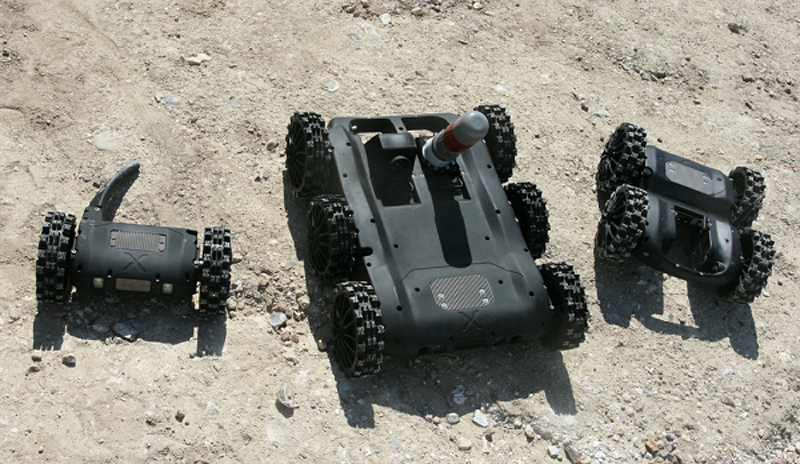
All Nexter Nerva robots were created with a view to quickly replacing the wheel in order to adapt the robot to the surface on which it will work.
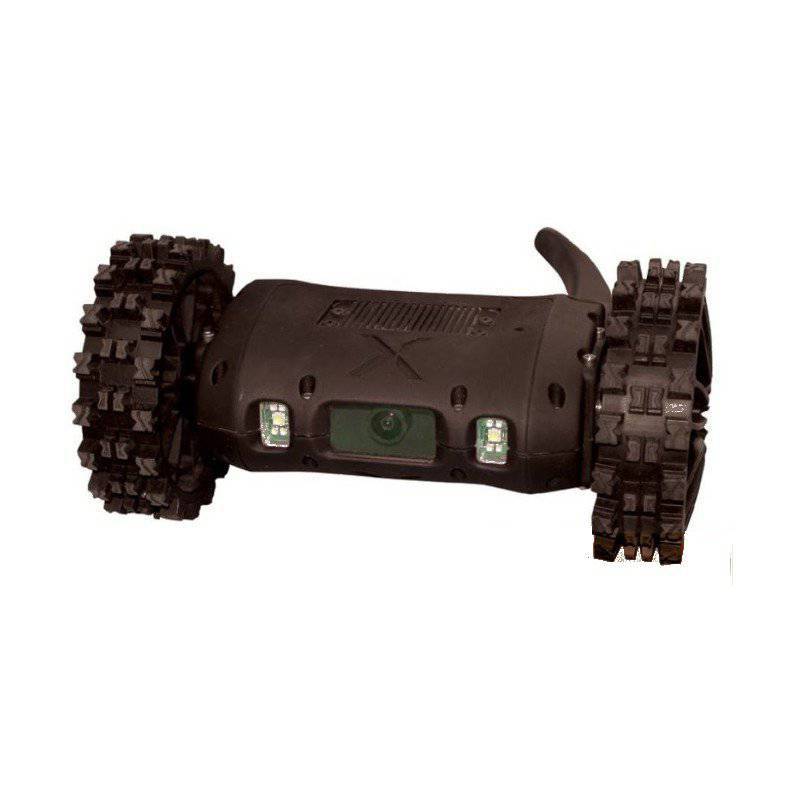
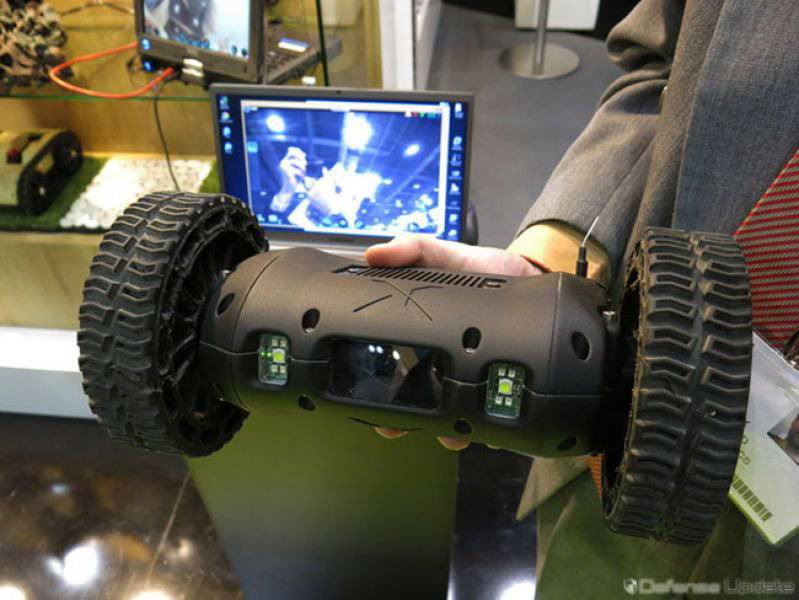
Nerva S is a lightweight member of the Nexter robot family; rear retractable handle is used not only to throw a robot, but also to turn it on
The serial model Nerva LG was shown at the Milipol 2013 exhibition together with its smaller brother Nerva S. This two-wheeled robot weighs only two kilograms, it can be used both indoors and in open areas; Lithium-ion battery on 21,6 volts with a capacity of 2700 mAh allows the device to operate continuously for 4 hours. Inclusion occurs due to the extension of the rear tail, which is folded along the body in order to save space in the transport configuration. The tail is used not only to stabilize the robot during operation, but also to throw it over long distances, even from a moving car. And since Nerva S was originally created as an abandoned system, its mass and strength allow it to be thrown through a window. As for the LG model, the replacement of the wheel is carried out in one motion. In order to increase mobility, wheel stops can be added on each side to install tracks, the front wheels in this case act as drive sprockets. This version of the robot was designated Nerva DS. Nerva S has the same speed range as LG and uses the same communication channel. It is equipped with a high-resolution camera and microphone, plus a backlight diode and a front infrared LED. The Nerva S model can also be deployed with additional devices that are mechanically attached to Picatinny guides. Robot Nerva S is produced serially.
Novatiq: The Swiss company produces a single model PocketBot. The robot is driven by three electric motors, all of them are installed in the housing, one of them rotates the third rear wheel through a belt drive. With a mass of just 850 grams, PocketBot can withstand a fall in the height of 8 meters and a throw to 30 meters. According to the company, the three-wheel configuration can significantly reduce its kinetic energy at impact compared to the four-wheel configuration. Immediately after landing and starting to move, PocketBot regains its normal position, since it is not a completely symmetrical system. The two main wheels are equipped with T-shaped protrusions, which ensure smooth movement on a flat surface, as well as optimum adhesion to sand, stones and vegetation. The third rear wheel is smooth, as tests have shown that T-shaped protrusions create excessive grip, significantly slowing the robot when cornering.
According to the company, the ground clearance of the PocketBot robot 14 mm allows you to cope with vertical obstacles 30 mm and slopes 40 °. In front of the case, there is a high resolution color camera, which rotates ± 90 °. In low light, the digital zoom camera x8 automatically switches to monochrome for low light. Infrared light is also available, however, the operator can switch it to manual mode to use white light. A waterproof microphone is installed, as well as a small waterproof loudspeaker that allows you to reach people near PocketBot, for example, a hostage. At the top of the PocketBot, there are attachment points for installing additional devices, such as a thermal imaging camera or chemical detectors. The equipment can be installed at the factory, but then in this case it is necessary to sacrifice the abandonment PocketBot. The device is activated by the upper switch, but it cannot be turned off by an outsider, since this can only be done from the control panel.
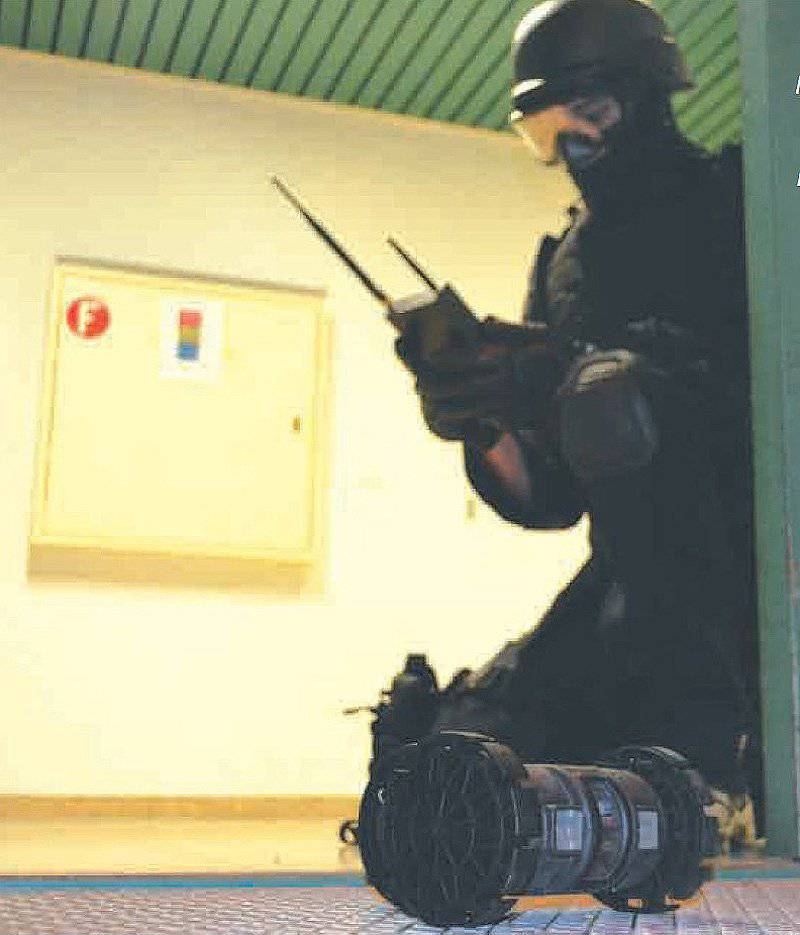
The three-wheeled robot PocketBot from the company Novatiq is designed for military and police forces
The two main wheels at PocketBot are specifically designed to provide maximum grip on different surfaces.
Thanks to its tracks, StoneMarten can cope with difficult terrain; Various systems can be installed on Picatinny rails.
Novatiq has developed the Crab-3 control unit. This unit weighing 0,7 kg and dimensions 200x110x450 mm has a color touch screen with a diagonal of 3,5 inch, it is powered by a quick-change battery. The same battery costs in the robot itself in order to reduce the logistic load, the continuous operation time is 4-5 hours. A digital video recording system also saves images on an SD card for further analysis. The PocketBot kit consists of one robot and one control unit, two chargers, four batteries, one headset, several spare parts, such as wheels, antennas, plugs, etc. At present, the configuration of the PocketBot platform is finally approved. It is offered by the customer with a standard data channel that provides 250 radius of operation in open areas and 70 meters in indirect visibility. Novatiq is ready to replace the communication channel according to the wishes of the customer, for example, with COFDM (Coded Orthogonal Frequency Division Multiplexing) system, orthogonal frequency division of coded signals. Novatiq has already received a number of orders in Europe and is ready to supply an unnamed customer from the Middle East for its special forces.
The second ground-based robot in the Novatiq portfolio is tracked and rather heavy. He received the designation StoneMarten and is designed to deploy sensors in high-risk areas on various types of terrain, as the tracks minimize size and weight while maximizing performance. The robot has already been sold to unnamed buyers from Europe and Africa. It weighs 4,5 kg, which allows you to define it in the category of abandoned robots with a big stretch; The permissible drop height is three meters and a drop of five meters. With two electric motors, it can reach a maximum speed of seven km / h, and special flipper devices allow the robot to climb stairs. This model is distinguished by a high-resolution front bending color camera, panning is performed by slowly moving the robot. Three more fixed color cameras are installed at the back and sides; All the cameras on each side are equipped with white and infrared LED lights, a microphone and a loudspeaker complete the standard package. Picatinny rails allow you to install additional equipment, four plug connectors are available for power supply, video signal and data transmission. The robot has some level of autonomy, for example, the ability to return to the last point with good communication quality or return to the operator. Like PocketBot, the StoneMarten robot currently has an approved configuration, but the company maintains a certain level of functional flexibility to meet customer needs.
Novatiq is currently developing a new series of unmanned vehicles, all under the designation Nova, followed by a suffix. All these products are still at the prototype stage and therefore all the technical specifications are preliminary. The smallest of the new line is the robot NovaCTR (Close Target Reconnaissance - intelligence of near targets), definitely belonging to the category of those being abandoned. It weighs 600 grams (even smaller than PocketBot), has a track configuration and can therefore be considered as an addition to a three-wheeled PocketBot. The device has the same impact strength as the robot Throwbot. The robot carries on its board a fixed front color camera with normal and infrared illumination, as well as a microphone and a loudspeaker. The claimed working range is 100 meters in line of sight and 30 meters in other cases. NovaCTR has an approved configuration and was recently added to the Novatiq portfolio; The company is currently negotiating with potential buyers.
NovaSSR - the latest product from the Swiss company Novatiq, but two more new robots are in the final design stage
There are a couple more robots in the company’s catalog, they are somewhat heavier, but they still fit into the category of those being abandoned. NovaMRR (Medium Range Reconnaissance - medium range reconnaissance) and Nova SRR (Short Range Reconnaissance - short range reconnaissance), respectively 4xXNNXX wheeled chassis and tracked chassis with flippers. However, these two chassis can be transformed, respectively, in tracked and wheeled. NovaMRR develops a greater maximum speed compared to the crawler counterpart - 4 km / h against 10 km / h - while the latter is able to overcome the steps. As for the throwing characteristics, the wheeled chassis can withstand a fall from four meters and a throw of six meters, and for the tracked counterpart, these figures are three and five meters, respectively. The MRR is equipped with a high-resolution front-facing color camera with a virtual panoramic zoom and three fixed color cameras mounted on the sides and rear to provide a circular 4,7 ° coverage. The SRR model also has a front-facing camera, but electrically tilted. While both robots are equipped with a microphone and a speaker for two-way communication with the operator, the tracked version also has white and infrared LEDs on all four sides. Both robots can carry devices with a total weight of 360 kg mounted on a Picatinny rail; an optional mechanical fastener with plate is also available; power supply and data transmission are carried out through connectors of the company Fischer Connectors.
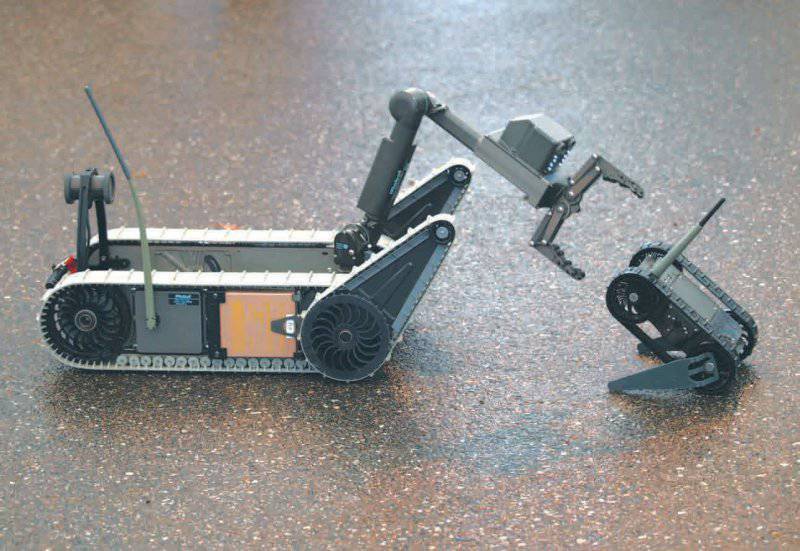
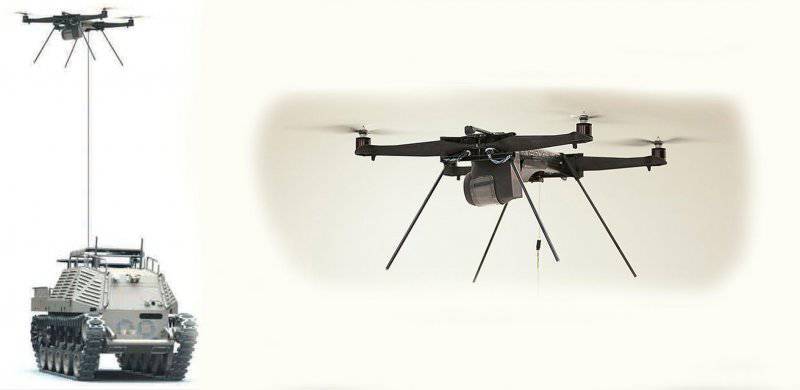
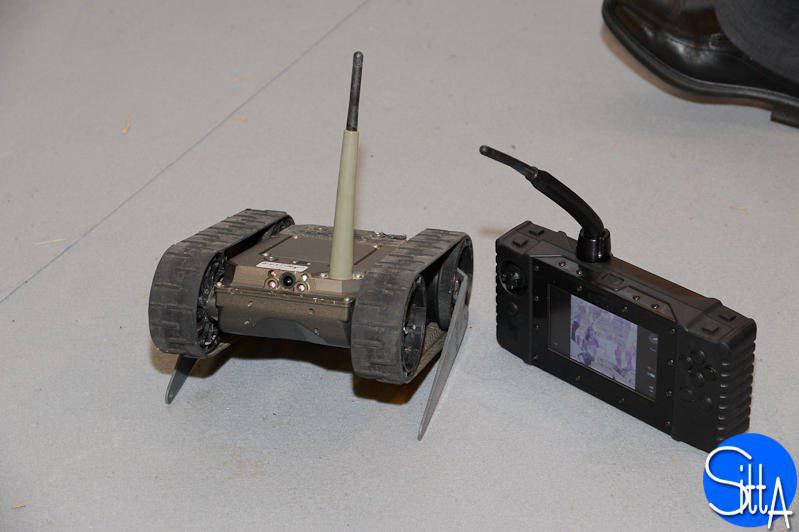
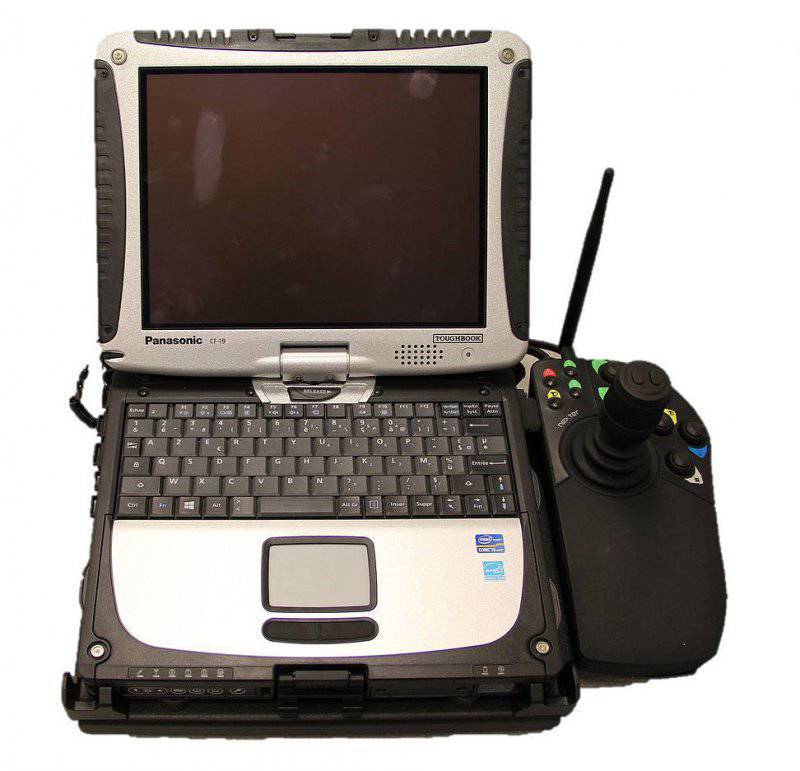

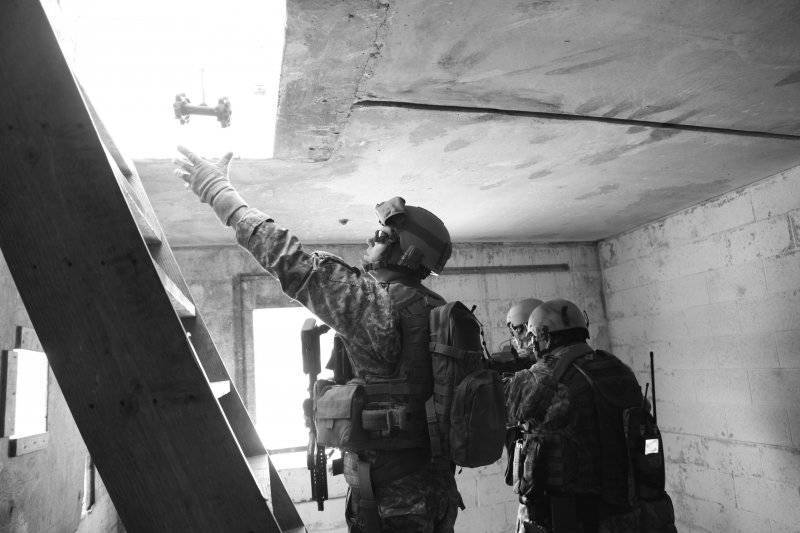
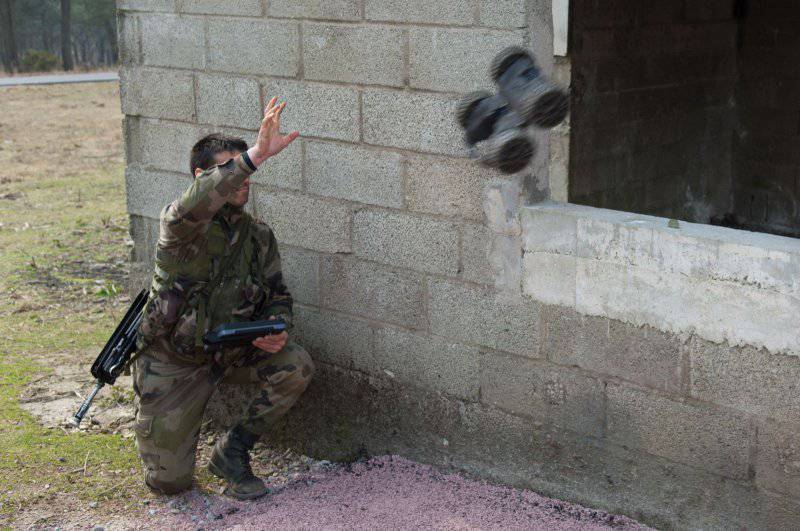
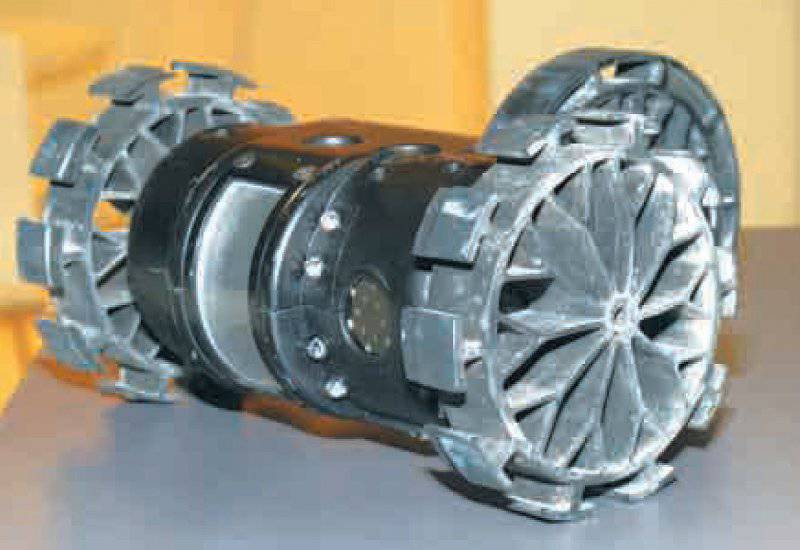
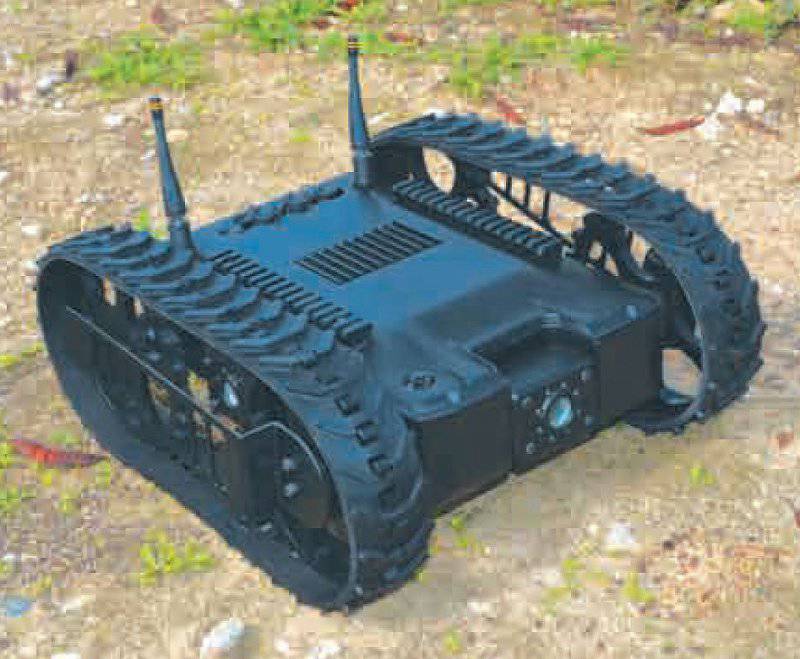
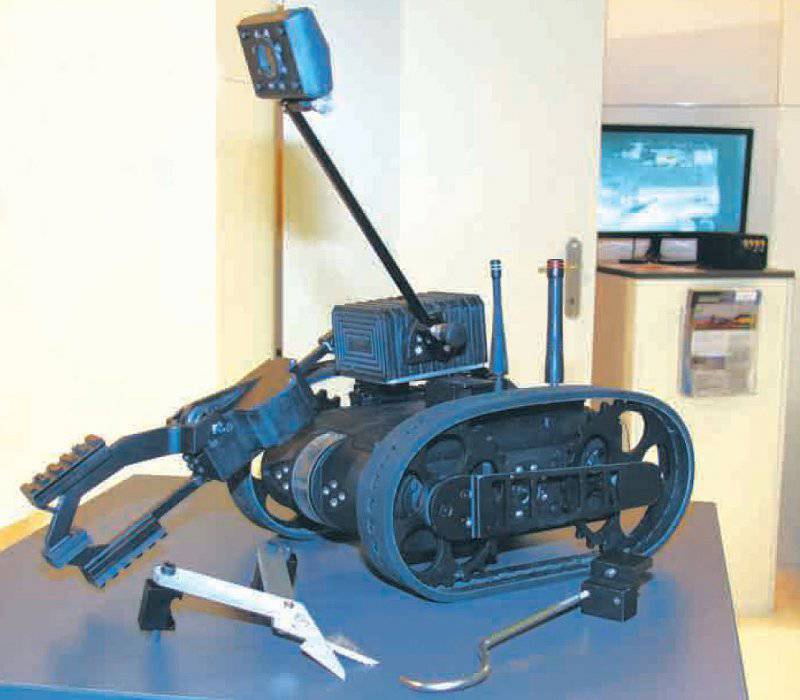
Information